|
Untitled Document
|
The
History
of Israel
- A Chronological Presentation

3.
The New State (1947 - 1957)
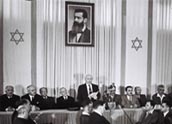 |
 |
|
David
Ben-Gurion reads Israel's
Declaration of Independence,
May 14. 1948. |
1947-48
- Preparation for War
Immediately after the UN's decision on the partition
of Palestine into one Jewish and one Arab state in
November 1947 Arab gangs began attacking Jewish communities
all over Palestine. The Arab World made clear its
determination to destroy the Jewish state, the moment
it was declared. As Britain prepared to pull out its
last troops, Jewish and Arab underground militia fought
to position themselves most favorably in anticipation
of the imminent Arab invasion.
The prospect of war made tens of thousands
of Palestinian Arabs, including most of the Arab elite,
leave Palestine. The intensification of the fighting,
as the expiration of the mandate approached, along with
circulation of rumors of both actual and fictitious
Jewish attacks on Arab villages, further accelerated
the flow of refugees. Before the war itself had really
begun, around 175.000 Arabs had already left Palestine.
 |
 |
|
Israel's
borders after the
armistice agreements of
1949. |
1948 - Israel's Independence War
On May 14, 1948 Israel's first prime minister, David
Ben-Gurion, proclamed the establishment of the new
Jewish republic. The next day the joint armies of
Egypt, Jordan, Syria, Lebanon and Iraq invaded the
Jewish state. Measured by firepower and military equipment
at the outset of war the Arabs were by far superior
to the Israelis. But lack of coordination and internal
strife between the Arab governments, along with the
higher morale and better organization of the Israeli
troops, caused the war to turn in Israel's favor.
When the final cease-fire came into
force in the spring of 1949, the Israelis con-trolled
about 40% more land than proposed by the UN partition
plan. Egypt and Jordan occupied the Gaza Strip and
the West Bank, respectively. The projected Arab, Palestinian
state never materialized. But it was also never requested,
neither by the Palestinian Arabs, nor by the rest
of the Arab World. Even though Israel's Arab neighbors
all signed armistice agreements with Israel, they
didn't recognize the Jewish state's right to exist.
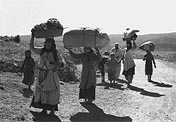 |
 |
| Palestinian
civilians flee from their
homes during the fighting in 1948. |
1948-53 - Arab and Jewish
Refugees
During the fighting many Palestinian Arabs fled or
were driven from the areas, which came under Israeli
control. Around 300.000 fled to the neighboring Arab
countries, while approximately 420.000 ended up in
refugee camps in the Arab occupied parts of Palestine.
The vast majority fled out of fear of the advancing
Israeli forces. But in certain places Arabs were forced
from their homes by Israeli troops. The Egyptian and
Jordanian controlled areas - including the Old City
of Jerusalem - were ethnically cleansed of Jews.
The moment the Jewish State had been proclamed in May
1948, the door was opened for the hundreds of thousands
of
Jewish refugees, who had
 |
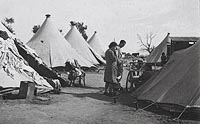 |
| Tent
camp for Jewish refugees near
Tel Aviv, 1948. |
survived the European Holocaust. In reaction to the founding
of Israel, Jews in Arab countries were subjected to
an unprecedented level of violence and persecution.
Israel launched a series of spectacular operations,
evacuating hundreds of thousands of Jews from Yemen
and Iraq. Most of Syria's and Lebanon's Jews also fled
to Israel, and later Jews arrived from Egypt, Tunesia,
Algeria, Libya, Morocco, Iran og Turkey. A total of
around 650.000 Jews fled from various Muslim countries
to Israel.
In stark contrast to Israel's reception
of over a million Jewish refugees, the Arab countries
- with their far greater capacity for absorption -
made no effort whatsoever of integrating the roughly
720.000 Palestinian Arab refugees. To the contrary,
they were strictly confined to refugee camps, serving
as a political tool in the ongoing fight against Israel.
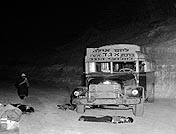 |
 |
| An
Arab attack on a bus in the
Negev Desert leave 11 Israelis
killed, 1954.
|
1950-55
- Border Skirmishes
In the years following Israel's first war both Egypt
and Jordan supported attacks by irregular forces across
the borders from the Gaza Strip and the West Bank into
Israel. The targets were usually Israeli civilians.
In respons Israel conducted systematic retaliatory raids
against the bases in Gaza and the West Bank, from where
the attacks were launched.
1956 - The Sinai
Crisis
From early 1954 Egypt took over Jordan's role
as the primary sponsor of terror against Israel, and during
the summer of 1955 Egyptian trained guerillas intensified
their attacks from Gaza. In the fall of the same year
the Egyptian naval blockade that denied Israeli shipping
access to both the Suez Canal and the Red Sea was expanded
to include the passage of foreign ships to the Israeli
Red Sea port of Eilat. The Egyptian president Nasser entered
into
 |
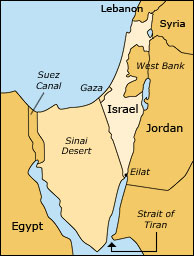 |
| Israel's
occupation of Gaza and the
Sinai peninsula, 1956-57.
|
a defense alliance with Syria, and the Soviet Union supplied
both countries with large amounts of modern weaponry,
far exceeding Israel's military capabilities. In an
official declaration Nasser now claimed to posess sufficient
military power to destroy Israel.
Under pressure, both militarily and
economically, Israel wished to extract itself from
the Egyptian stranglehold. And when Nasser in 1956
threatened British and French interests by nationalizing
the Suez Canal, the two great powers supported Israel's
invasion of Gaza and the Sinai Desert, hereby putting
an end to both the terror attacks and the blockade
of Eilat. British and French forces bombed Egyptian
airfields and occupied the area around the Suez Canal.
The international community, headed by the United
States pressured England, France and Israel to withdraw
its forces. A UN force was established in order to
monitor the demilitarization of the Sinai and Gaza,
and the US guaranteed Israel's future access to the
Red Sea. The last Israeli troops were pulled out in
March 1957.
Continue:
Chapter 3 - The New State - Page 2
Back
|
Untitled Document
|